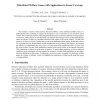Free Online Productivity Tools
i2Speak
i2Symbol
i2OCR
iTex2Img
iWeb2Print
iWeb2Shot
i2Type
iPdf2Split
iPdf2Merge
i2Bopomofo
i2Arabic
i2Style
i2Image
i2PDF
iLatex2Rtf
Sci2ools
CDC
2008
IEEE
2008
IEEE
Distributed welfare games with applications to sensor coverage
We consider a variation of the resource allocation problem. In the traditional problem, there is a global planner who would like to assign a set of players to a set of resources so as to maximize social welfare. We consider the situation where the global planner does not have the authority to assign players to resources; rather, players are self-interested. The question that emerges is how can the global planner entice the players to settle on a desirable allocation with respect to the social welfare? To study this question, we focus on a class of games that we refer to as distributed welfare games. Within this context, we investigate how the global planner should distribute the social welfare to the players? We measure the efficacy of a distribution rule in two ways: (i) Does a pure Nash equilibrium exist? (ii) How does the social welfare of a pure Nash equilibrium compare to the social welfare of the optimal allocation? This comparison is referred to as the price of anarchy. To ans...
| Added | 29 May 2010 |
| Updated | 29 May 2010 |
| Type | Conference |
| Year | 2008 |
| Where | CDC |
| Authors | Jason R. Marden, Adam Wierman |
Comments (0)

